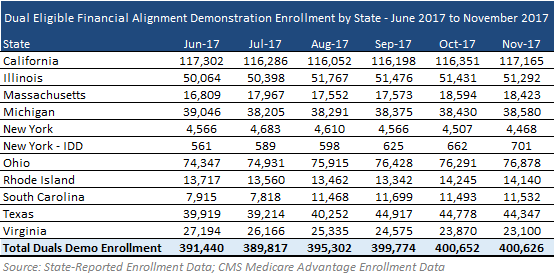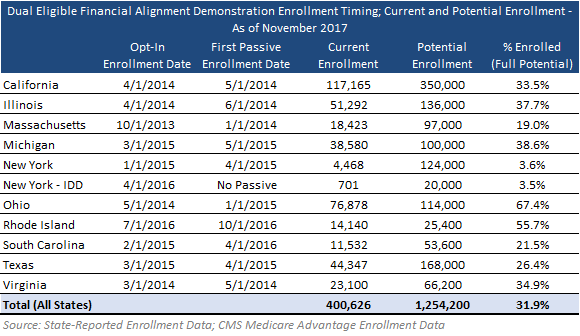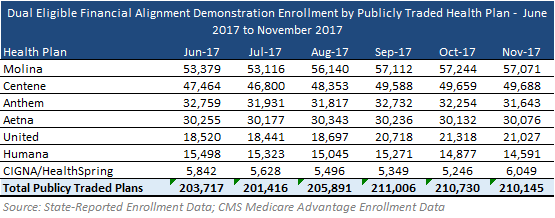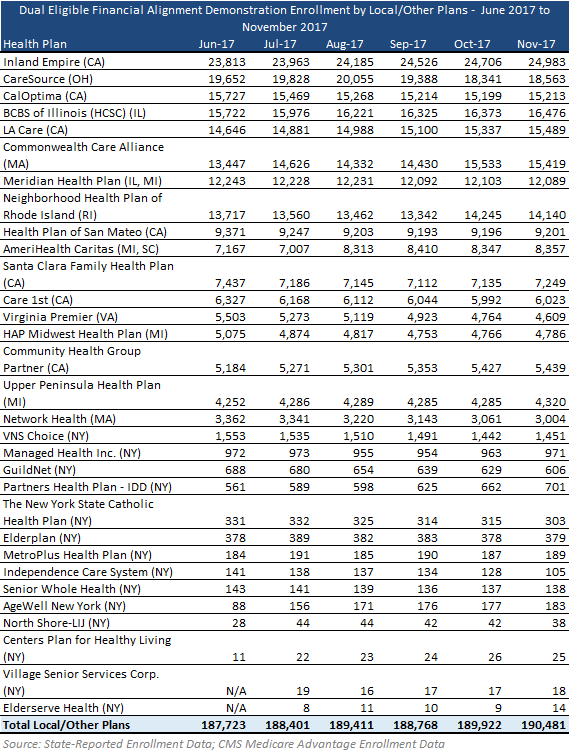This week, our In Focus section reviews publicly available data on enrollment in capitated financial and administrative alignment demonstrations (“Duals Demonstrations”) for beneficiaries dually eligible for Medicare and Medicaid (duals) in 10 states: California, Illinois, Massachusetts, Michigan, New York, Ohio, Rhode Island, South Carolina, Texas, and Virginia. Each of these states has begun either voluntary or passive enrollment of duals into fully integrated plans providing both Medicaid and Medicare benefits (“Medicare-Medicaid Plans,” or “MMPs”) under three-way contracts between the state, the Centers for Medicare & Medicaid Services (CMS), and the MMP. As of November 2017, more than 400,000 duals are enrolled in an MMP, the second-highest monthly enrollment since the demonstrations began, according to state and CMS enrollment reports.
Note on Enrollment Data
Six of the ten states (California, Illinois, Massachusetts, Michigan, New York, and South Carolina) report monthly on enrollment in their Dual Demonstration plans, although there is occasionally a lag in the published data. Other states publish intermittent enrollment reports.
Duals Demonstration plan enrollment is also provided in the CMS Medicare Advantage monthly enrollment reports, which are published around the middle of each month. In the table below, we provide the most current state-reported data, with CMS data supplementing where needed. Historically, we have seen minor inconsistencies between state-reported data and the CMS enrollment report, likely due to discrepancies in the timing of reports.
Dual Demonstration Enrollment Overview
As of November 2017, more than 400,000 dual eligibles were enrolled in a demonstration plan across the ten states below. Since November 2016, enrollment in Dual Demonstrations across all states is up by nearly 36,000 members, a 9.8 percent year-over-year increase. As noted in the introduction, November 2017 represents the second-highest ever duals demonstration enrollment total, due in part to the launch of Rhode Island’s demonstration in late 2016. Virginia’s Dual Demonstration enrollment is the only program that has experienced steady declines in enrollment over the last six months, which is likely related to the program sunsetting at the end of 2017, with any remaining members transitioning to the state’s new managed long-term services and supports program in 2018.

So far, enrollment in these ten states represents nearly 32 percent of the potential enrollment of more than 1.25 million across all ten capitated demonstration states. Participation rates range from a low of less than 4 percent in New York to more than 65 percent in Ohio. The newest demonstration state, Rhode Island, is already at more than 55 percent participation.

Dual Demonstration Enrollment by Health Plan
As of November 2017, more than half (52 percent) of all duals in the demonstrations are enrolled in a publicly traded MMP. This is down slightly from more than 54 percent in January 2017. Molina and Centene are the largest in terms of enrollment with more than 57,000 and 49,000 demonstration enrollees, respectively.

Among non-publicly traded health plans, Inland Empire in California is the largest, with nearly 25,000 members, making it the fifth largest MMP nationwide. CareSource (Ohio), CalOptima (California), Blue Cross Blue Shield of Illinois (Illinois), LA Care (California), Commonwealth Care Alliance (Massachusetts), Meridian (Illinois and Michigan), and now Neighborhood Health Plan of Rhode Island all have more than 10,000 enrolled members as of November 2017. Enrollment by non-publicly traded health plans for the past six months is detailed below.
